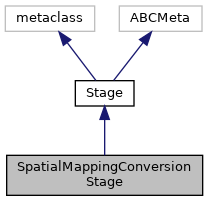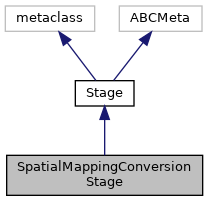Pipeline stage that converts the spatial mapping from a user-provided spatial mapping across operational array dimensions to the internal spatial mapping representation used in the cost model. More...


Public Member Functions | |
| def | __init__ (self, list[StageCallable] list_of_callables, *Accelerator accelerator, LayerNode layer, **Any kwargs) |
| Initialize the accelerator and layer attributes. More... | |
| def | run (self) |
| tuple[SpatialMappingInternal, SpatialMappingInternal] | convert_user_spatial_mapping (self, SpatialMapping user_spatial_mapping) |
Convert the SpatialMapping instance in user-defined format (spatial mapping across operational array dimensions) to the SpatialMappingInternal representation. More... | |
| None|tuple[LayerDim, UnrollFactor] | generate_limited_user_spatial_mapping (self, LayerDimSizes layer_dim_sizes, OADimension oa_dim, tuple[LayerDim, UnrollFactor] spatial_loop, SpatialMapping user_spatial_mapping, SpatialMapping limited_user_spatial_mapping, bool allow_decimal_sm_loop_size=True) |
| SpatialMappingPerMemLvl | generate_mapping_per_mem_lvl (self, SpatialMapping user_spatial_mapping) |
| This function is to convert spatial mapping to mapping_per_mem_lvl, which attaches spatial mapping to different memory levels. More... | |
| def | check_if_oa_dim_mapping_is_first_max (self, OADimension oa_dim, LayerDim loop_dim_unrolled, SpatialMapping user_spatial_mapping) |
| For the case when there is layer dimension that is mapped on multiple oa dimensions. More... | |
| UnrollFactor | calc_unrolled_loop_size_on_early_oa_dims (self, OADimension oa_dim, LayerDim loop_dim_unrolled, SpatialMapping user_spatial_mapping) |
 Public Member Functions inherited from Stage Public Member Functions inherited from Stage | |
| def | __init__ (self, list["StageCallable"] list_of_callables, **Any kwargs) |
| def | __iter__ (self) |
| bool | is_leaf (self) |
Public Attributes | |
| layer | |
| accelerator | |
| memory_operand_links | |
| user_spatial_mapping | |
 Public Attributes inherited from Stage Public Attributes inherited from Stage | |
| kwargs | |
| list_of_callables | |
Detailed Description
Pipeline stage that converts the spatial mapping from a user-provided spatial mapping across operational array dimensions to the internal spatial mapping representation used in the cost model.
Constructor & Destructor Documentation
◆ __init__()
| def __init__ | ( | self, | |
| list[StageCallable] | list_of_callables, | ||
| *Accelerator | accelerator, | ||
| LayerNode | layer, | ||
| **Any | kwargs | ||
| ) |
Initialize the accelerator and layer attributes.
Member Function Documentation
◆ calc_unrolled_loop_size_on_early_oa_dims()
| UnrollFactor calc_unrolled_loop_size_on_early_oa_dims | ( | self, | |
| OADimension | oa_dim, | ||
| LayerDim | loop_dim_unrolled, | ||
| SpatialMapping | user_spatial_mapping | ||
| ) |

◆ check_if_oa_dim_mapping_is_first_max()
| def check_if_oa_dim_mapping_is_first_max | ( | self, | |
| OADimension | oa_dim, | ||
| LayerDim | loop_dim_unrolled, | ||
| SpatialMapping | user_spatial_mapping | ||
| ) |
For the case when there is layer dimension that is mapped on multiple oa dimensions.
We need to decide on which oa dimension to adjust the unrolling if the total unrolling size is not a multiple of the layer dimension size. In this case, we decide to only adjust the unrolling size of the first oa dimension with the largest unrolling. This function is to check if the given oa_dim has the largest unrolling for the given loop_dim_unrolled.

◆ convert_user_spatial_mapping()
| tuple[SpatialMappingInternal, SpatialMappingInternal] convert_user_spatial_mapping | ( | self, | |
| SpatialMapping | user_spatial_mapping | ||
| ) |
Convert the SpatialMapping instance in user-defined format (spatial mapping across operational array dimensions) to the SpatialMappingInternal representation.
For this conversion we need to know:
- the user defined spatial mapping
- the core (i.e. operational array) on which the unrolling happens,and the memory hierarchy that is connected to that operational array.
- Parameters
-
user_spatial_mapping The SpatialMapping in user-definedformat to be converted.
- Returns
- : A SpatialMappingInternal object with the converted spatial mapping.


◆ generate_limited_user_spatial_mapping()
| None | tuple[LayerDim, UnrollFactor] generate_limited_user_spatial_mapping | ( | self, | |
| LayerDimSizes | layer_dim_sizes, | ||
| OADimension | oa_dim, | ||
| tuple[LayerDim, UnrollFactor] | spatial_loop, | ||
| SpatialMapping | user_spatial_mapping, | ||
| SpatialMapping | limited_user_spatial_mapping, | ||
| bool | allow_decimal_sm_loop_size = True |
||
| ) |


◆ generate_mapping_per_mem_lvl()
| SpatialMappingPerMemLvl generate_mapping_per_mem_lvl | ( | self, | |
| SpatialMapping | user_spatial_mapping | ||
| ) |
This function is to convert spatial mapping to mapping_per_mem_lvl, which attaches spatial mapping to different memory levels.
TODO This should be a class

◆ run()
| def run | ( | self | ) |
Reimplemented from Stage.


Member Data Documentation
◆ accelerator
| accelerator |
◆ layer
| layer |
◆ memory_operand_links
| memory_operand_links |
◆ user_spatial_mapping
| user_spatial_mapping |
The documentation for this class was generated from the following file:
- /home/runner/work/zigzag/zigzag/zigzag/stages/mapping/spatial_mapping_conversion.py